When people think about breathtakingly beautiful flooring, their minds commonly go to hardwood. The uniqueness of the grain, the luxurious feel, the sense of warmth, and other benefits are just too hard to overlook. However, when it comes to hardwood floors in a bathroom, there’s often a debate about whether it’s a good idea.
Technically, you can use hardwood floors in a bathroom. However, you’ll want to choose the right wood and commit to ongoing maintenance and care. Sealing the floor might also be a necessity. Otherwise, moisture and spills can damage the hardwood, potentially beyond repair.
Taking care of wood floors in bathrooms is more challenging than you see with other flooring types, but it is manageable if you use the right approach. If you’re considering hardwood floors in your bathroom, here’s what you need to know.
Contents (Jump to Topic)
- Can You Use Hardwood Floors in a Bathroom?
- Wood Floors in Bathroom Pros and Cons
- Best Hardwood Floor for Bathroom
- How to Prevent Damage to Hardwood Floors in a Bathroom
- How to Seal Wood Floors in Bathroom
- How to Protect Wood Floor Around Toilet
- Alternatives to Hardwood for Bathrooms
- Can Engineered Hardwood Be Used in Bathrooms?
- How to Clean Hardwood Floors in Bathroom
- Are New Hardwood Floors in a Bathroom Covered by the Warranty?
- Bathrooms With Hardwood Floors Pictures
- Should You Install Wood Flooring in Bathrooms?
Can You Use Hardwood Floors in a Bathroom?
Yes, you can use hardwood floors in a bathroom. While a high humidity environment where spills are common isn’t an ideal environment for wood, going with hardwood isn’t typically against building codes. That means you aren’t restricted from going in that direction.
However, before installing wood floors in a bathroom, you need to ensure you’re willing to handle the ongoing maintenance and care requirements. Hardwood takes more work in rooms where moisture is high, and spills and splashes are common. Without the proper routine, your floors may end up damaged or in disrepair sooner than expected.
Wood Floors in Bathroom Pros and Cons
Since using wood floors in your bathroom is a riskier choice, you’ll want to weigh the pros and cons to determine if it’s the best move. Here’s a look at the benefits and drawbacks of hardwood floors in a bathroom.
Pros
There are several benefits to using hardwood floors in bathrooms. Generally speaking, wood floors feel good under your feet. Since a bathroom is an area of the home where people spend at least some time barefoot, that can make hardwood seem like a good choice.
Hardwood is also visually pleasing. Most people enjoy the look of wood floors, suggesting the stain and finish matches their aesthetic. Plus, depending on the finish, hardwood isn’t naturally slippery, which could prevent falls in a bathroom.
In some cases, hardwood in a bathroom could increase the value of your home. That’s mainly true if you’re replacing a less desirable flooring type but could apply in general if it is well maintained and appealing overall.
Wood floors often have a great lifespan, too. Thanks to its durability, it isn’t uncommon to get 25 years or more out of hardwood flooring before you have to worry about replacement.
Finally, hardwood floors imbue a sense of warmth. Since a bathroom can seem visually cold or sterile, that’s a bonus. If you decide to heat your wood floors, they create warmth in more ways than one, which can make the space more comfortable and might boost your property value.
Cons
When it comes to the drawbacks of using hardwood in a bathroom, the biggest is that water is the enemy of wood. High humidity can cause wood floors to swell, expand, and warp. Sometimes, you could experience cupping, crowning, buckling, or cracking.
Water spills can cause similar issues. However, they may also lead to surface discoloration, as water sitting on the surface may harm the finish or alter the color. The same can be true if certain soaps, body washes, and other products commonly used in bathrooms come in contact with the floor.
In some cases, hardwood may require more maintenance than other flooring types. For example, you’ll never have to worry about sanding or refinishing tile. Additionally, mold and mildew prefer organic materials like wood, so you may have more trouble controlling it if you have hardwood flooring.
Finally, installing new hardwood is a significant financial investment. Often, it costs far more than many alternatives, including some that can give you a wood look. While this may be offset based on the longevity you get with hardwood, that only applies if you maintain it properly, so keep that in mind.
Best Hardwood Floor for Bathroom
Generally speaking, you want to choose a hardwood that’s dense and less likely to absorb moisture. Several options can work well, allowing you to get the look, color, and finish you’re after.
One classic option is teak. It’s naturally water-resistant due to oils in the wood. Plus, it’s one of the toughest woods and highly resistant to brittleness, cracking, and warping.
White oak is another solid choice. The same goes for ash, cherry, hickory, maple, and walnut. Each has unique coloring and grain patterns, so you can find an option that best aligns with your aesthetic.
If you’d like, you could also consider cedar. Western red cedar is naturally moisture-resistant, but the bright color and strong smell may not work for all households. Additionally, it isn’t as dense as some alternatives, so it can show wear faster.
How to Prevent Damage to Hardwood Floors in a Bathroom
If you install hardwood floors in your bathroom, you want to take steps to preserve and protect it. Most of them involve preventing moisture and water-related damage, as that’s often the biggest risk to the longevity of a wood floor.
Regular Maintenance
Many hardwood floors have a finish that serves as a protective barrier. As a result, you’ll want to make sure that you maintain that finish to ensure moisture isn’t easily absorbed into the wood.
Every few months, place a drop of water on different spots on your floor, focusing on high-traffic paths. It the water beads, your finish is in good shape. If it sinks, then you need to refresh the finish quickly to prevent future damage.
If you see cracks or chips developing in your hardwoods, you may want to apply a wood filler quickly. Which type of filler is best may depend on your finish and the size of the cracks or ships, so research your options to figure out which approach is ideal for your situation.
Cleaning Up Spills
As mentioned previously, water, cleansers, and other liquids that come in contact with your wood floors can cause damage. By addressing spills immediately, you reduce the odds of them harming the finish, discoloring the wood, or warping the planks. Plus, it helps prevent mold and mildew.
In most cases, you’ll want to wipe up spills with a clean microfiber cloth. That material isn’t likely to scratch the finish and is highly absorbent, making it a solid choice.
Bath Mats
Bath mats give you another layer of protection. By setting one against the tub or shower, small splashes or drips won’t reach the hardwood. Keeping one near the sink helps catch spills from that area, while one around the toilet could prevent splashes or condensation from causing damage.
Tub and Shower Tile Surrounds
The best way to preserve hardwood floors in a bathroom is to reduce the chances of any contact with water. Adding a tile surround to your tub and shower can reduce the odds of water reaching your hardwood floor.
Sometimes, you may want to extend the tile a few feet off the tub or shower. That gives you a place to step out of the shower or tub and dry off before stepping on the hardwood. Plus, it makes the distance splashes need to travel longer, making it less likely they’ll reach your wood floors.
Inspecting Plumbing Regularly
Plumbing leaks are more likely if your fixtures and connections aren’t in good shape. By regularly inspecting the plumbing in your bathroom, you may notice changes that signal it’s time to replace a fixture or connection.
Generally, you’ll want to inspect the water and drain lines under your sink and at the back of your toilet. Also, keep an eye on shower heads and tub faucets. If you spot significant wear and tear or drips, it’s better to take action immediately than to wait until a small issue develops into a large problem.
Wood Floor Sealer
Certain wood floor sealers can add a water-resistant barrier, preventing splashes and spills from coming in contact with the hardwood. In some cases, this finish is applied during the manufacturing process, though you may need to reapply it after it starts to wear away.
Additionally, if you’re installing unfinished hardwood floors, there won’t be any protection. Since that’s the case, you’ll want to choose a sealer that provides water resistance and gives you the right finish.
How to Seal Wood Floors in Bathroom
In many cases, sealing wood floors in a bathroom is reasonably straightforward. You’ll want to start with a clean surface and make sure that any existing finish that could hinder the application or the sealer adhering correctly is removed.
After that, the approach you use depends on the product type. Some people prefer hard wax oil. The oil and wax create a functional protective barrier once it’s cured. However, it can become dull or dingy over time, particularly if you don’t clean the flooring regularly to remove dirt, dust, and grime.
Others use teak, tung, or linseed oil, particularly for unfinished flooring. Generally, tung oil is the most water-resistant option. Plus, it’s easy to apply, requiring little more than a soft, clean cloth and a bit of rubbing and drying time between and after the coats.
Alternatively, you could consider an option like lacquer. It’s more durable and long-lasting than many oils. You could also consider oil-based polyurethane for a tough finish that can protect your wood floors from water and moisture.
With lacquers, polyurethane, and similar options, you’ll want to check the manufacturer’s instructions regarding preparation, application, and drying times. Each could have its own recommendations, so it’s better to look at the specifics before starting your project.
How to Protect Wood Floor Around Toilet
Generally, you’ll want to use a two-part approach to protect the wood floor around your toilet. First, make sure that the wood is properly sealed. That gives you a strong initial barrier that can reduce the harm caused by splashes, drips, or leaks.
Second, get a bath mat that fits around the toilet’s base. This allows the mat to catch some of the splashes and drips. Just make sure that it doesn’t get saturated, as that can trap moisture against your floor. Also, clean that bath mat regularly, as not everything it catches is water.
You could also consider a toilet base plate. That serves as a barrier between the base of your toilet and your flooring. Just be aware that you’ll need to remove the toilet to install many base plates, which can be a somewhat cumbersome process.
Alternatives to Hardwood for Bathrooms
Laminate Flooring
A classic substitute for hardwood floors, laminate can have colors and patterns (and potentially textures) that mimic genuine wood flooring. It also stands up better to the occasional drip or splash and is reasonably stain resistant.
However, laminate is not waterproof. If the water soaks into the layers, it can cause your laminate flooring to swell and warp. Plus, it weakens the glue that holds the layers together, which can cause the board to fail.
Additionally, different products may offer varying levels of water resistance. Since that’s the case, you’ll want to explore your options to find a product line that’s best for bathrooms.
Luxury Vinyl
Another product that can give you a wood look without the hassles that come with hardwood is a luxury vinyl plank. Often, this option is practically waterproof, as the vinyl isn’t damaged by water or humidity. However, if water gets beneath the planks, it can harm your subfloor or other structural elements.
The main benefit of luxury vinyl flooring is that the look is incredibly convincing. Plus, it can offer more surface durability, making it great for high-traffic areas.
In many cases, luxury vinyl is also pleasant underfoot and has enough texture to reduce your odds of slips or falls. If you choose the right product line, you can heat luxury vinyl floors. Just make sure you select a product designed with heating in mind.
Linoleum
In some cases, going with a wood-look linoleum in a bathroom could be a reasonable alternative to hardwood. Linoleum is durable and easy to maintain in most circumstances. Plus, it’s environmentally friendly.
However, there are some drawbacks when it comes to linoleum. First, they may not have the texture you’d find with normal wood, and some designs can look fake. Second, water exposure can cause issues.
Water can discolor linoleum, and removing the stain isn’t an option. If water sits, it may also loosen the flooring or create bubbles and warping, which you might not be able to repair, making replacement the only option.
It’s also important to note that new linoleum does have a slight odor due to the linseed oil used to create it. That smell can last for months and may be overwhelming in spaces like bathrooms that are usually smaller and don’t always have great airflow.
Can Engineered Hardwood Be Used in Bathrooms?
Using engineered hardwood in a bathroom is an option, but it isn’t a risk-free approach. The surface features a wood veneer that can be damaged or stained by water if the finish isn’t adequately maintained.
However, engineered hardwood performs much better when it comes to humidity. The way its constructed can reduce your odds of swelling, warping, and similar issues. Keep in mind that ongoing leaks or sitting water can still penetrate, leading to problems like those previously mentioned.
How to Clean Hardwood Floors in Bathroom
Cleaning a hardwood floor in a bathroom isn’t unlike tackling it in any other area of the house. Usually, you’ll want to start with a broom or a vacuum (using the hardwood floor attachment or setting) to remove surface dust, dirt, and debris.
After that, you’ll transition to a mop. A flat-head design and a microfiber pad can prevent scratches, which could be the better choice.
When it comes to the cleaner, choose the best option for your current finish. Ideally, you’ll want to apply it with a spray bottle, allowing you to work in small sections. Apply a heavy mist, then mop with the grain.
At that point, you can let the floor dry. However, if you have the excess cleaner on your floor, you may want to take a clean, microfiber cloth or mop to remove what’s on the surface of your flooring. That ensures it doesn’t have a chance to sit for long and potentially cause damage.
Are New Hardwood Floors in a Bathroom Covered by the Warranty?
One of the most appealing parts about new hardwood floors is the lengthy warranty. Some companies guarantee their products for 20 or 30 years, and a few go beyond that.
However, installing hardwood in a bathroom can alter your warranty coverage. Many companies void the warranty for wood flooring installed in high-risk areas, including bathrooms. The risk of damage caused by failing to address spills or leaks is simply too high, so they opt not to offer protection.
Others offer limited coverage against manufacturer defects or issues not caused by water or humidity exposure. Some may even require that homeowners take specific steps to address possible water-related issues or exposure, which may be far stricter than most people can manage. As a result, a warranty may become void simply because you can’t keep up the what the company requires.
If you’re concerned about whether your hardwood floors are covered by a warranty, make sure to read the warranty thoroughly before purchase. That lets you find caveats, exclusions, and similar points that may apply to your installation. Then, you can decide if moving forward is the best option.
Bathrooms With Hardwood Floors Pictures
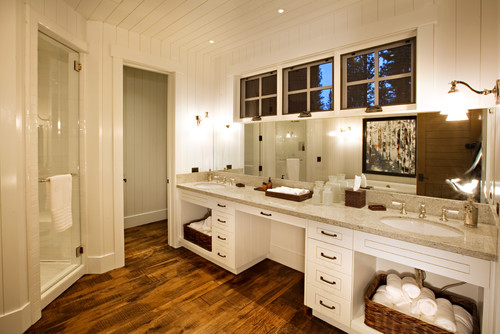
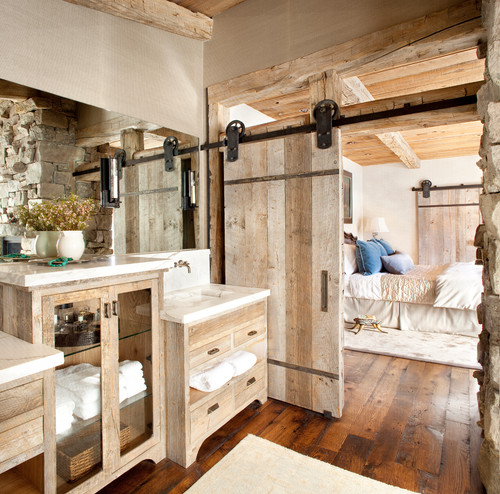
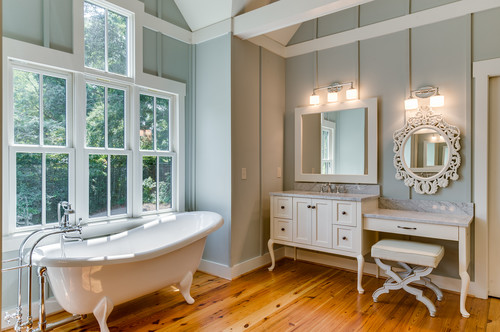
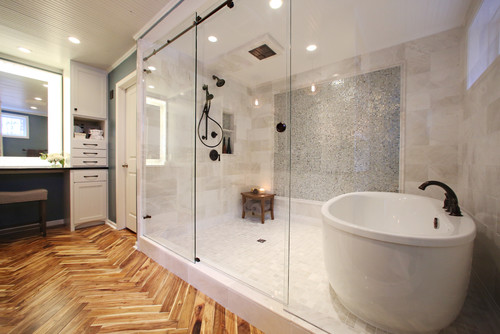
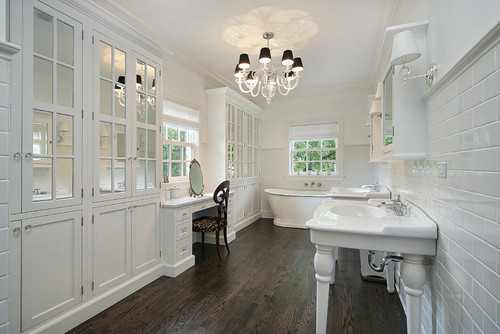
Should You Install Wood Flooring in Bathrooms?
Installing hardwood floors in a bathroom does come with risks, as the moisture levels and potential for spills are high. However, if you’re willing to do the work required to keep the hardwood flooring in good shape, there’s no reason not to go in that direction. Just choose the right hardwood to ensure it has the best chance of staying in excellent condition.
Did you learn everything you wanted about using hardwood floors in a bathroom? If so, let us know in the comments below. Also, if you have a family member, friend, or colleague debating whether hardwood floors are a good fit for their bathroom, make sure to share the article.




